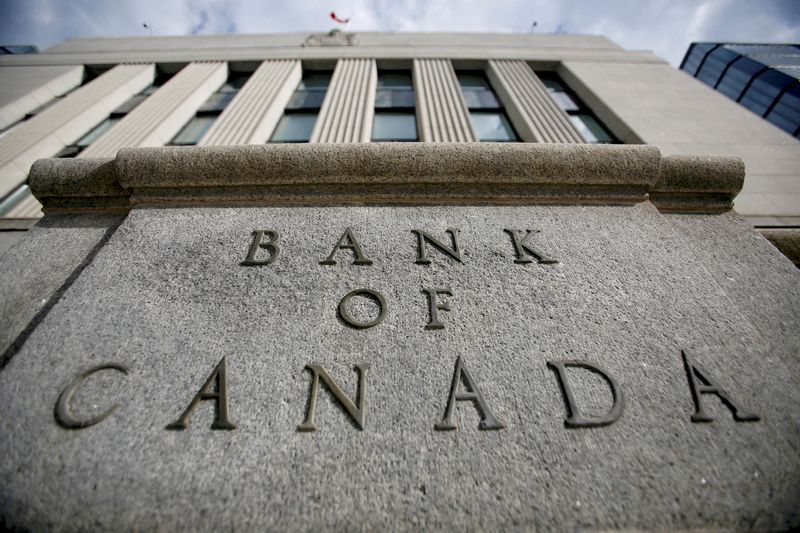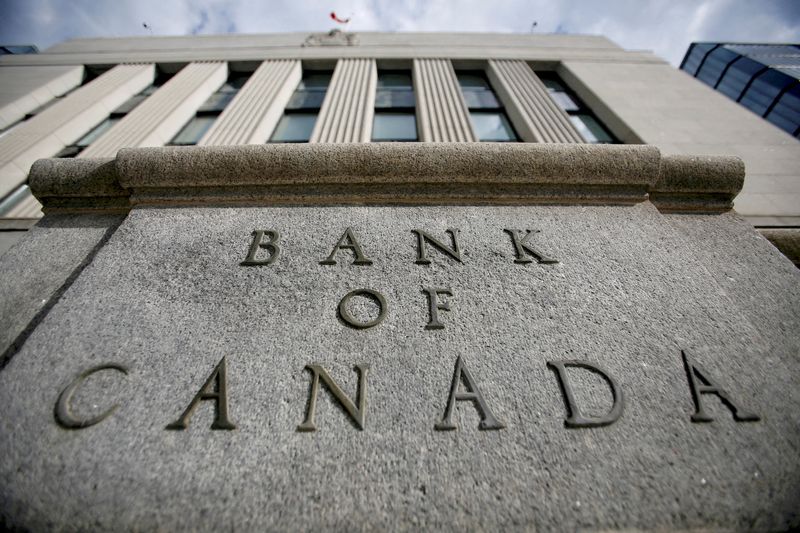Economy
Bank of Canada to hold rates steady on Sept. 6; home prices to fall in 2023: Reuters poll


© Reuters. FILE PHOTO: A sign is pictured outside the Bank of Canada building in Ottawa, Ontario, Canada, May 23, 2017. REUTERS/Chris Wattie/File Photo
By Milounee Purohit and Devayani Sathyan
BENGALURU (Reuters) – The Bank of Canada is expected to hold its key interest rate steady at 5.00% on Sept. 6 and stay at that level through at least the end of March 2024, according to a majority of economists in a Reuters poll, with a small but growing minority expecting one more rate rise.
Inflation, which the Canadian central bank targets at 2%, rose more than expected to 3.3% in July, and further price rises continue to be the upside risk to expectations the BoC has already reached its terminal rate.
The housing market, where prices surged about 50% during the coronavirus pandemic and have fallen only about 10% from their peak, is also showing signs of a revival, with forecasters in a separate Reuters poll raising price expectations for this year.
For the time being, an expected slowdown in economic growth to 1.1% in the second quarter and a rise in the jobless rate gives Bank of Canada policymakers plenty of room to leave interest rates unchanged next week.
Thirty-one of 34 economists polled Aug. 24-30 expect no change to the central bank’s overnight rate, with the remaining three expecting a 25-basis-point rise. Interest rate futures are pricing in no change next week, but are nearly split over whether rates rise once more.
“Our base case call at the moment is for them to keep the overnight rate steady at 5.00% … (and) throughout the rest of this year,” said Claire Fan, an economist at RBC.
Fan pointed out that by the October meeting, policymakers will have two more job market and inflation reports to consider.
In the latest poll, eight of 34 economists expect one more rate rise to 5.25% by the end of this year, compared with only one in a July poll. In response to an additional question, 60% of respondents, 12 of 20, said the risk of the central bank raising rates once more from the current level was high.
“We expect the Bank will hold the overnight rate steady at 5.00% through mid-2024 as the full impact of past rate hikes helps push the economy into a moderate recession. Still, additional BoC rate hikes are possible if economic growth is stronger than we anticipate,” said Tony Stillo, the director of Canadian economics at Oxford Economics.
A majority of economists, 24 of 34, expect the central bank will keep its policy rate at the current level or higher until at least the end of March 2024. The median shows 50 basis points worth of cuts by the end of June next year, in line with expectations for the U.S. Federal Reserve.
A scenario in which Canadian interest rates stay higher for longer could increase pressure on highly-indebted households, with almost 20% of Canadian mortgages due for renewal next year.
The Aug. 14-29 poll of 13 property analysts forecast average home prices would fall 5.0% this year, less severe than the nearly 9% drop expected just three months ago. Analysts expected a 12% fall in home prices at the beginning of the year.
“We’re not anticipating further rate increases from the Bank of Canada, but that threat alone is enough to keep buyers on the sidelines for the rest of this year,” said Sal Guatieri, senior economist at BMO Capital Markets.
“It won’t be until early next year … when it becomes clear the bank’s next move is to lower rates, that we’ll see the housing market strengthening once again.”
The prospect of higher mortgage repayments on ever-more expensive property, along with record immigration, is expected to drive further demand for rentals.
When asked what will happen to average rents for the rest of 2023, all 10 analysts said they would either rise slightly (5) or rise significantly (5). A majority of analysts also said rental affordability would worsen over the coming year.
“I think rents will continue to rise across Canada because of the shortage of housing that we’re seeing and the underlying sturdy demand,” BMO’s Guatieri said.
(For other stories from the Reuters global economic poll:)
Economy
Russian central bank says it needs months to make sure CPI falling before rate cuts -RBC


© Reuters. Russian Central Bank Governor Elvira Nabiullina attends a news conference in Moscow, Russia June 14, 2019. REUTERS/Shamil Zhumatov/File Photo
MOSCOW (Reuters) – Russia’s central bank will need two to three months to make sure that inflation is steadily declining before taking any decision on interest rate cuts, the bank’s governor Elvira Nabiullina told RBC media on Sunday.
The central bank raised its key interest rate by 100 basis points to 16% earlier in December, hiking for the fifth consecutive meeting in response to stubborn inflation, and suggested that its tightening cycle was nearly over.
Nabiullina said it was not yet clear when exactly the regulator would start cutting rates, however.
“We really need to make sure that inflation is steadily decreasing, that these are not one-off factors that can affect the rate of price growth in a particular month,” she said.
Nabiullina said the bank was taking into account a wide range of indicators but primarily those that “characterize the stability of inflation”.
“This will take two or three months or more – it depends on how much the wide range of indicators that characterize sustainable inflation declines,” she said.
The bank will next convene to set its benchmark rate on Feb. 16.
The governor also said the bank should have started monetary policy tightening earlier than in July, when it embarked on the rate-hiking cycle.
Economy
China identifies second set of projects in $140 billion spending plan


© Reuters. FILE PHOTO: Workers walk past an under-construction area with completed office towers in the background, in Shenzhen’s Qianhai new district, Guangdong province, China August 25, 2023. REUTERS/David Kirton/File Photo
SHANGHAI (Reuters) – China’s top planning body said on Saturday it had identified a second batch of public investment projects, including flood control and disaster relief programmes, under a bond issuance and investment plan announced in October to boost the economy.
With the latest tranche, China has now earmarked more than 800 billion yuan of its 1 trillion yuan ($140 billion) in additional government bond issuance in the fourth quarter, as it focuses on fiscal steps to shore up the flagging economy.
The National Development and Reform Commission (NDRC) said in a statement on Saturday it had identified 9,600 projects with planned investment of more than 560 billion yuan.
China’s economy, the world’s second largest, is struggling to regain its footing post-COVID-19 as policymakers grapple with tepid consumer demand, weak exports, falling foreign investment and a deepening real estate crisis.
The 1 trillion yuan in additional bond issuance will widen China’s 2023 budget deficit ratio to around 3.8 percent from 3 percent, the state-run Xinhua news agency has said.
“Construction of the projects will improve China’s flood control system, emergency response mechanism and disaster relief capabilities, and better protect people’s lives and property, so it is very significant,” the NDRC said.
The agency said it will coordinate with other government bodies to make sure that funds are allocated speedily for investment and that high standards of quality are maintained in project construction.
($1 = 7.1315 renminbi)
Economy
Russian central bank says it needs months to make sure CPI falling before rate cuts -RBC


© Reuters. Russian Central Bank Governor Elvira Nabiullina attends a news conference in Moscow, Russia June 14, 2019. REUTERS/Shamil Zhumatov/File Photo
MOSCOW (Reuters) – Russia’s central bank will need two to three months to make sure that inflation is steadily declining before taking any decision on interest rate cuts, the bank’s governor Elvira Nabiullina told RBC media on Sunday.
The central bank raised its key interest rate by 100 basis points to 16% earlier in December, hiking for the fifth consecutive meeting in response to stubborn inflation, and suggested that its tightening cycle was nearly over.
Nabiullina said it was not yet clear when exactly the regulator would start cutting rates, however.
“We really need to make sure that inflation is steadily decreasing, that these are not one-off factors that can affect the rate of price growth in a particular month,” she said.
Nabiullina said the bank was taking into account a wide range of indicators but primarily those that “characterize the stability of inflation”.
“This will take two or three months or more – it depends on how much the wide range of indicators that characterize sustainable inflation declines,” she said.
The bank will next convene to set its benchmark rate on Feb. 16.
The governor also said the bank should have started monetary policy tightening earlier than in July, when it embarked on the rate-hiking cycle.

 Forex2 years ago
Forex2 years agoForex Today: the dollar is gaining strength amid gloomy sentiment at the start of the Fed’s week

 Forex2 years ago
Forex2 years agoHow is the Australian dollar doing today?

 Forex1 year ago
Forex1 year agoUnbiased review of Pocket Option broker

 Forex2 years ago
Forex2 years agoDollar to pound sterling exchange rate today: Pound plummeted to its lowest since 1985

 Cryptocurrency2 years ago
Cryptocurrency2 years agoWhat happened in the crypto market – current events today

 World2 years ago
World2 years agoWhy are modern video games an art form?

 Stock Markets2 years ago
Stock Markets2 years agoMorgan Stanley: bear market rally to continue

 Economy2 years ago
Economy2 years agoCrude oil tankers double in price due to EU anti-Russian sanctions

































